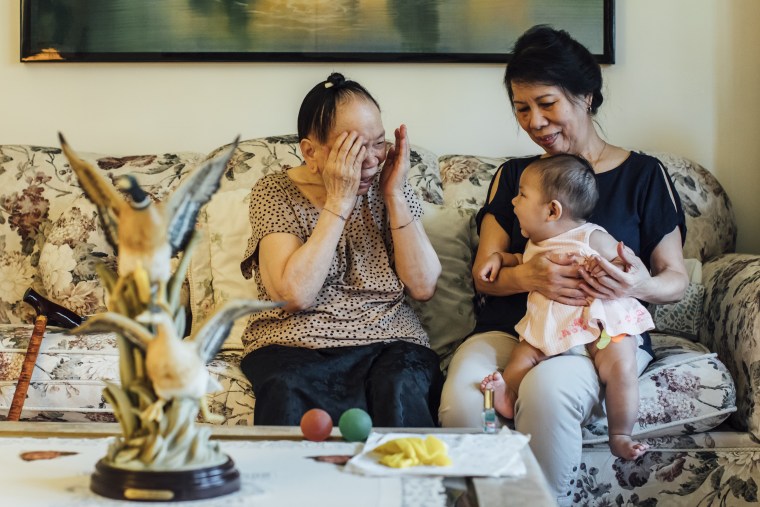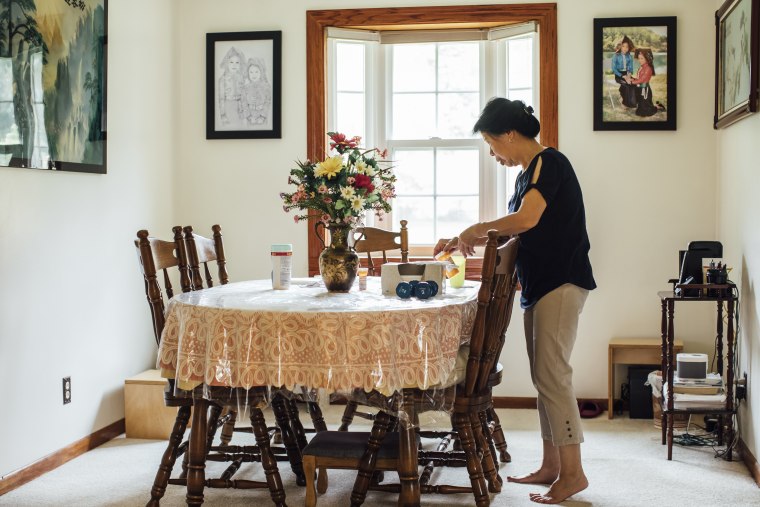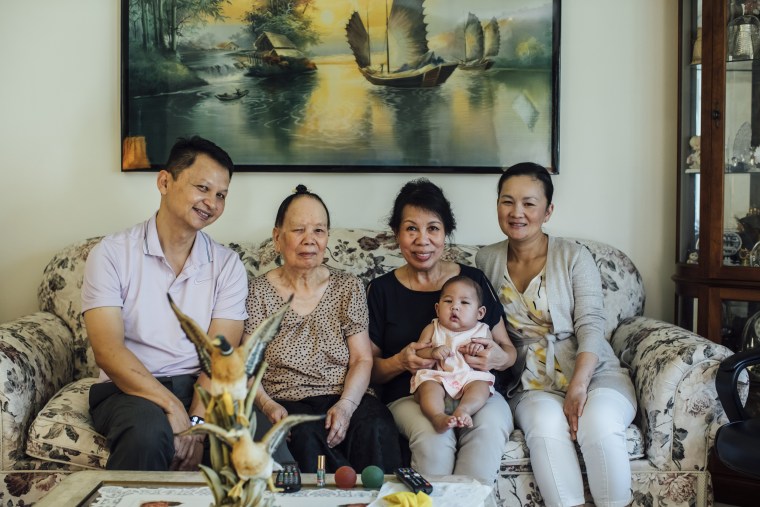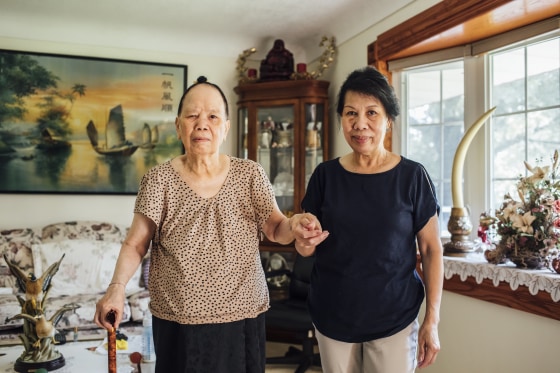DES MOINES, Iowa — Nan Lo, 66, and her mother Eune Lo, 87, were watching a talent show on television one recent Tuesday morning when there came a knock on the door. It was Chris, Eune’s son, with his wife and baby. Soon with a cooing little one to bounce on their knees, the whole atmosphere brightened.
Nan is paid to be the full-time caretaker for her mother by an agency provider program called Asian Home Care. Eune stays home, and Nan cooks, cleans and helps to bathe her mother in the comfort of her own home.
There’s a reason why they agreed to leave war-torn Laos in 1975 as part of a group of Tai Dam refugees. That reason is here, in this living room on a quiet street in Des Moines, where they are surrounded by family, light and care.
An AARP survey shows that many adults 50 or older prefer staying in their homes post-retirement but very few are able to do so. Even fewer can afford a long-term caretaker.
Eune not only prefers homecare, she also wouldn’t be comfortable in an average American retirement community because she speaks little English, her primary language being Tai Dam.
“I know they are taking good care of people in nursing homes. But I just don't like it,” she said through a translator.

Eune is part of a rapidly-growing older Asian American population with few options for long-term care.
According to the Pew Research Center, every day for the next 10 years more than 10,000 people will turn 65 each day.
National Asian Pacific Center on Aging’s research found that 42 percent of Asian Pacific Islanders provide care to older adults compared to 22 percent of the general population. Many studies show that cultural traditions instruct Asian Americans to care for their older adults though many may not have the resources to choose their preferred care situation. In 2016, 11.8 percent of Asian Americans, ages 65 and older, were at or below the poverty level. In comparison, the rate for older Americans overall was 9.3 percent.
“The aging population is facing loneliness and mental illness,” said Rooshey Hasnain, clinical assistant professor with the Department of Disability and Human Development at the University of Illinois at Chicago. “It’s the result of lack of resources in families or across families or the formal institutions who are not reaching everyone they should be reaching.”
In order for her mother to retire from her job at a car manufacturing plant, Nan Lo had to get a second job cleaning houses in the evening. Eune relies on both Medicaid and Medicare. While Medicare does not cover nursing homes, Medicaid offers waivers for older adults that allow family members to receive payments for home- or community-based long term care.

Using the waiver, Tom Baccam started Asian Home Care in 2012 and received funding to pay Nan to be a care provider for her mom. After years of being a community advocate for the area’s Tai Dam population, Baccam saw a widespread necessity for supporting older people.
The needs of older adults are prominent concerns in many immigrant communities. In 1973, a senior services organization called On Lok, which is Cantonese for “peaceful, happy home,” pioneered a model that mixed home care with time at a day center in San Francisco’s Chinatown.
Without having to move to a nursing home, older people could access health services at central locations that housed primary care and social workers. The model is now known as the Programs of All-Inclusive Care for the Elderly (PACE) and is operational in 31 states.
By 2021, Seattle will be home to a partnership, known as AiPACE, between Kin On, a culturally-sensitive retirement community for Asian people, and International Community Health Services using the PACE model. With the help of influential local leaders such as Martha Choe, the first Korean American woman to be elected to public office in the U.S., and longtime community organizer Paul Mar, AiPACE aims to raise $20 million in order to both build its health care center and reclaim space in central Seattle’s Chinatown.
In the state of Washington, nursing home facilities are rapidly shutting down. AiPACE capital campaign manager Heidi Wong said the model is not sustainable and is at threat of fading out.
“Less and less people and if given a choice nobody wants to move out of their home,” Wong said. “It’s a national trend that transcends ethnicity.”
In Chicago, South Asian immigrants started Sahara Home Care, which matches non-medical home care aides with older people who live at home. With funding from the Illinois Department on Aging, the groups are able to fill what was a niche in the Chicago area, according to Kulsoom Fatima Khan, Sahara’s public relations coordinator. Only about half of their clients are Asian now and they offer aides who can speak Urdu, Bengali, Hindi, Spanish, Tagalog and Malayalam among other languages. In July, Sahara opened its ninth location.
Despite the lack of suitable caregiving institutions for older people, a survey of Asian elders living in New York City showed that the median migration age was 51-62 years old with many noting they moved because of family members already in the U.S.
Still, Asian Americans are trying to find solutions. Linda Louie, 57, based in Seattle, made the decision to place her mother in a nursing home because she could no longer safely navigate the stairs in her home. Louie has been planning on purchasing a one-level home before she retires herself. Louie has kids but she says they have their own lives, jobs and children.

Some, like Nan, have been ready for this their whole life. She always knew that someday she would be caring for her mother.
“I love her, she’s my mother,” Nan said. Her brother who was sitting in the next room echoed that he would provide a home for her, too. “Of course,” he said. If not, then she would stay with others in his family.
Baccam, 60, is less sure of what will happen as he ages. He bikes 20 miles almost every day to stay healthy.
“I don’t know what the future will be,” he said. “Even if my kids love me.”
CORRECTION (Sept. 26, 2019, 11:42 a.m. ET): A previous version of this story misspelled the last name of a Seattle resident on one reference. She is Linda Louie, not Louis.
Follow NBC Asian America on Facebook, Twitter, Instagram and Tumblr.
